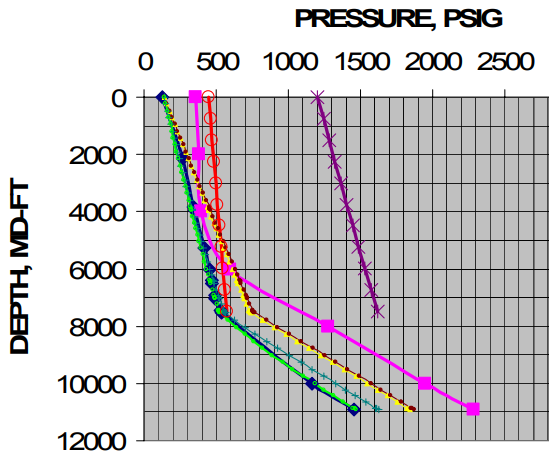The purpose of this article is to present rough guides, or “rules of thumb”, to consider when preparing a Flowing Gradient Survey job program for gas lifted well. These recommendations will guide Production Engineers when preparing the survey instruments, planning the survey stop depths and times, when planning to obtain the bottomhole pressure data, as well as when preparing the job program for running pressure & temperature survey.

Preparing the survey instruments:
- Run sinker bars as needed to overcome pressure surges when entering the wellhead from the lubricator.
- Sampling rate should be at 30-second intervals.
- Calibrate the electronic gauge with its software prior to each use.
Planning the survey stop depths and times:
- Stop at least every 1000 ft (305 m), include stops at mandrels, and mid points between mandrels.
- Stop 30 ft (9 m) above and below each valve
- If a well is producing in a stable manner (steady CHP/THP), the stops above and below each valve should be for 10 min to assure that a stable reading is obtained.
- If the well is heading, stop at each valve for about 1.1 to 1.2 times the heading period (or for sufficient time to observe the minimum and maximum pressure in slugging, surging wells). [For that we need to plot WHP with time for wells equipped with automatic pressure recording system].
- In heading wells, it may not be necessary to obtain flowing pressure stops near the upper valves in severely heading wells to reduce the risk of wireline tangling or gauge damage.
- In heading wells, to further prevent problems, extra weight bars should be added, and a “no-blow” device used to prevent the pressure recorders from being blown up the hole (the no-flow (or no-blow) device is equipped with “dogs” or slips that are activated by sudden movement up the hole (however they are not 100% reliable, so care must be taken when running a flowing pressure survey in a heading well.
Obtaining bottomhole pressure data:
- Obtain enough flowing pressure readings below the point of injection to extrapolate the flowing pressure gradient to the mid-point of the perforations.
- If possible, a heading well should be stabilized before the FBHP is measured, even if it is necessary to use extraordinary means. One way to do this, for many wells, is to temporarily over-inject too much gas. Many heading wells can be temporarily stabilized in this fashion.
Recommended procedures for running pressure survey:
- Insert the pressure/temperature gauges into the lubricator, set on the wellhead, open the crown or master valve, let pressure equalize for 15 minutes or until the well is stable or normal;
- Many operators consider the stops below the gas-lift valves most important. Stops can also made above the valves if the well is not heading or surging too strongly. Making additional stops between valves can be helpful in plotting and interpreting the survey.
- Some operators like to make stops both below and above each gas-lift valve. If a temperature survey is conducted to locate the depth of gas injection, the instrument must be stopped at the depth of the mandrel or immediately above it to record the cooling effect of gas entering the production stream. High flow rates relative to the tubing size may prevent or minimize the chances of detecting a temperature change.
- Install the lubricator and pressure recording instruments. Record the surface pressure in the lubricator for 15 minutes. Calibrate the pressure in the lubricator with a dead-weight tester. Run the survey instruments, making stops 15 ft to 30 ft (4.57 m to 9.14 m) below each gas-lift valve for 15 minutes. Shorter or longer stops may be dictated by well conditions. For example, if a well is surging or heading, each stop should be for 1.1 to 1.25 times the heading period. Do not shut the well in while rigging up or recording flowing pressures in the tubing.
- Leave the recording instruments on bottom for at least 30 minutes, or longer if a static pressure is to be read.
- Pressure surging may aggravate sand problems.
Reference: API RP 11V5: RECOMMENDED PRACTICES FOR OPERATION, MAINTENANCE, SURVEILLANCE, AND TROUBLESHOOTING OF GAS-LIFT INSTALLATIONS





